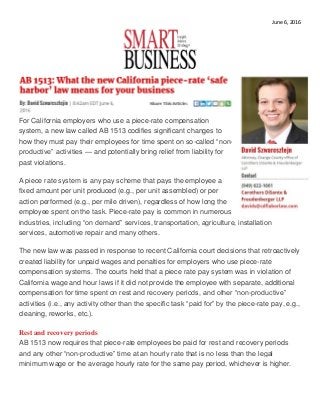
AB1513 - Smart Business - 6-6-16
- 1. June 6, 2016 For California employers who use a piece-rate compensation system, a new law called AB 1513 codifies significant changes to how they must pay their employees for time spent on so-called “non- productive” activities — and potentially bring relief from liability for past violations. A piece rate system is any pay scheme that pays the employee a fixed amount per unit produced (e.g., per unit assembled) or per action performed (e.g., per mile driven), regardless of how long the employee spent on the task. Piece-rate pay is common in numerous industries, including “on demand” services, transportation, agriculture, installation services, automotive repair and many others. The new law was passed in response to recent California court decisions that retroactively created liability for unpaid wages and penalties for employers who use piece-rate compensation systems. The courts held that a piece rate pay system was in violation of California wage and hour laws if it did not provide the employee with separate, additional compensation for time spent on rest and recovery periods, and other “non-productive” activities (i.e., any activity other than the specific task “paid for” by the piece-rate pay, e.g., cleaning, reworks, etc.). Rest and recovery periods AB 1513 now requires that piece-rate employees be paid for rest and recovery periods and any other “non-productive” time at an hourly rate that is no less than the legal minimum wage or the average hourly rate for the same pay period, whichever is higher.
- 2. In addition, the employee’s pay stub must reflect the total number of compensable “non- productive” hours worked by the employee, and the applicable rate of pay and gross wages for such periods. In addition, the law also created a “safe harbor” period that allows employers to become compliant with the new requirements, while limiting their exposure to past liability provided certain conditions are met. In order to avoid liability for certain kinds of damages and penalties available under state law, an employer must: (a) by no later than July 1, 2016, provide written notice to the Department of Industrial Relations of the company’s election to make such payment under the “safe harbor” law, (b) by no later than Dec. 15, 2016, provide compensation for past uncompensated time from July 1, 2012 to Dec. 31, 2015 to current and former employees who were paid on a piece rate basis during those time periods but were not compensated for rest periods, recovery periods or other “unproductive time,” and (c) provide certain specified notices to the affected employees regarding the compensation being provided under the “safe harbor” law. Taking advantage of this “safe harbor” provision gives an employer facing potential liability (especially in the context of a class action lawsuit) significant protections. This includes avoiding penalties and liquidated damages under various provisions of the Labor Code, including the potentially disastrous penalties that can be assessed under the Private Attorneys General Act of 2004 (Labor Code section 2699). Don’t despair Many employers who have used piece rate compensation systems without any issue for years will find that the new requirements are too impractical, burdensome or expensive for their businesses now. However, they need not despair as there are several alternatives available that enable them to protect themselves from potential liability, while still incentivizing and rewarding their employees for achieving high productivity levels. Because the changes will affect each business differently, owners and managers should be sure to consult with employment counsel on the best way to manage these changes.
- 3. David Szwarcsztejn is an attorney in the Orange County office of Carothers DiSante & Freudenberger LLP, an award-winning California labor and employment law firm. Szwarcsztejn represents California employers in a wide variety of employment claims, including wrongful termination, wage and hour violations, discrimination, harassment, breach of contract, trade secrets, fraud and unfair competition. He also works with clients on employee workplace solutions, advice and training. He can be reached at davids@cdflaborlaw.com or (949) 622-1661.